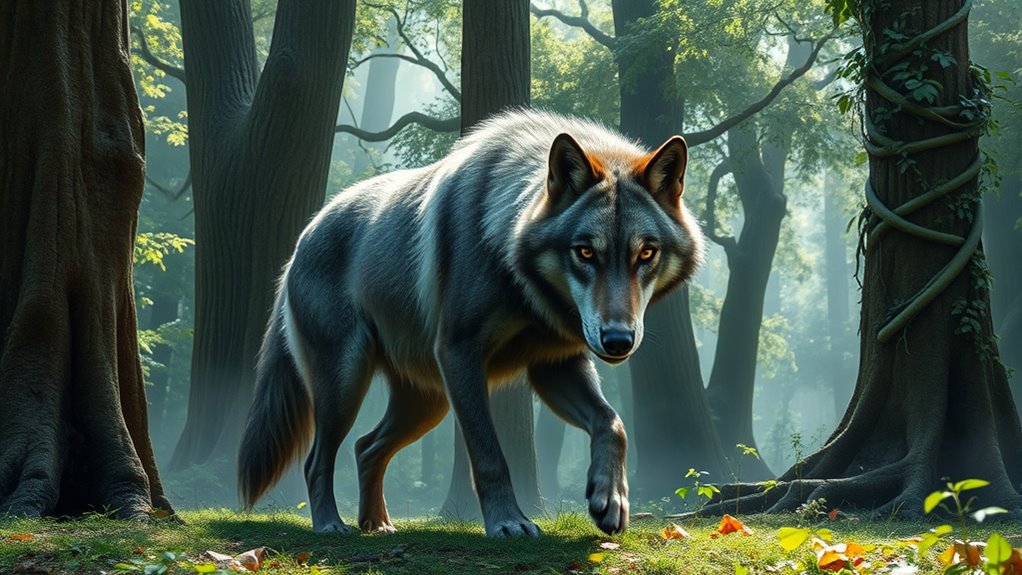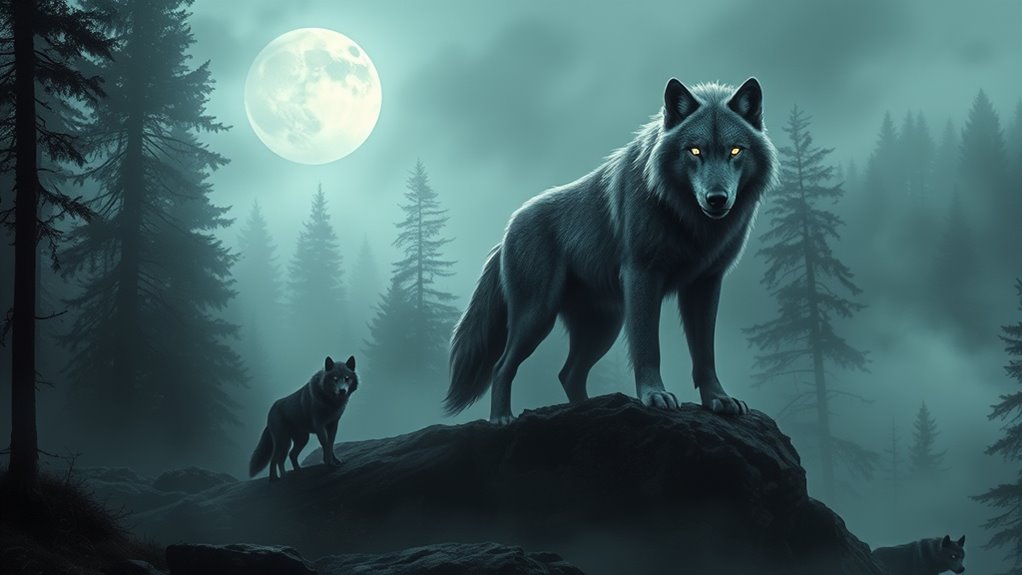Colossal Biosciences is on the verge of bringing dire wolves back to life using groundbreaking genetic techniques. By employing cloning and genome reconstruction, they’re reshaping our understanding of de-extinction. These majestic predators once roamed North America, and now, you might witness their revival. This initiative also has implications for conservation and endangered species, showcasing how genetic technologies can transform ecosystems. Stick around to uncover more about this thrilling journey into the past!
Key Takeaways
- Colossal Biosciences is leveraging genetic technologies to explore the possibility of de-extincting the dire wolf, a species that vanished thousands of years ago.
- The company utilizes genome reconstruction and cloning techniques to analyze and replicate the dire wolf’s genetic makeup for potential revival.
- Insights from the dire wolf’s unique adaptations and social structures guide modern conservation efforts and genetic engineering strategies for endangered species.
- Genetic modifications and targeted gene editing can enhance the resilience and health of current wolf populations, echoing traits of the ancient dire wolf.
- Ethical considerations and legal frameworks are crucial in guiding the de-extinction process to avoid unintended ecological consequences.
The Science Behind De-Extinction

While the idea of bringing extinct species back to life might seem like science fiction, the reality is rooted in groundbreaking advancements in genetic technology.
You’ll find that the de-extinction process involves several techniques. Cloning methods, like somatic cell nuclear transfer, allow scientists to transfer nuclei from extinct species into egg cells. Genome reconstruction helps in inferring genetic sequences for comparison. Sound waves can also influence the effectiveness of these techniques by aiding in the cellular processes involved. Back-breeding living species can also restore traits of their extinct relatives. Modern DNA sequencing tools enable the analysis of ancient genetic data. Surrogate mothers, closely related to the extinct species, carry the embryos. Comprehensive hearing evaluations are essential to understanding the complexities of genetic information and ensuring successful outcomes. Additionally, the application of essential oils for stress relief can support the well-being of those involved in the scientific process, enhancing focus and reducing anxiety. Somatic therapy techniques, which emphasize the mind-body connection, can also play a role in helping researchers cope with the emotional challenges of their work. Embracing challenges in this groundbreaking field requires a growth mindset, as researchers navigate the complexities of de-extinction.
The de-extinction process utilizes advanced cloning methods and genome reconstruction to revive extinct species through innovative genetic techniques.
Together, these methods pave the way for reviving species, such as the dire wolf, showcasing the potential of genetic innovation in conservation.
Genetic Technologies Revolutionizing Conservation

Genetic technologies are revolutionizing conservation efforts in unprecedented ways. You’ll see how targeted gene editing boosts disease resistance in endangered species, like the black-footed ferret, making them more resilient against threats.
This technology isn’t just about saving one species; it enhances genetic diversity through “gene rescue,” which strengthens entire populations.
You’ll also encounter innovative de-extinction projects aiming to revive species like the woolly mammoth. Genetic modifications can help combat diseases affecting wildlife, ensuring healthier ecosystems.
Plus, strategies to control invasive species, such as gene drives, protect native biodiversity. Ancient civilizations understood the importance of maintaining biodiversity through sustainable practices, a concept that modern conservation efforts echo today.
The Dire Wolf: a Glimpse Into the Past

The dire wolf, a fascinating symbol of Ice Age fauna, roamed the North American landscape thousands of years ago. Standing 28 to 33 inches tall and weighing up to 150 pounds, these formidable predators measured five to six feet from head to tail.
Their larger, broader skulls and robust limbs gave them a distinct advantage in diverse environments. Evidence suggests they’d a varied diet, possibly engaging in osteophagy, while their cold-adaptive traits helped them thrive in frigid climates.
Likely living in packs, dire wolves exhibited social structures similar to modern wolves. Though they went extinct around 10,000 years ago, their fossils reveal much about their evolutionary history and morphological variations across regions.
Implications for Endangered Species

Understanding the dire wolf’s past not only sheds light on its unique adaptations but also raises important questions about the future of endangered species. Genetic engineering can play a vital role in conservation, especially as traditional methods often fall short. By enhancing the resilience of endangered species through gene editing, you can help them adapt to environmental changes or combat diseases. Additionally, the preservation of biodiversity hotspots is crucial for maintaining ecosystem health amidst these genetic advancements. Decluttering spaces can contribute to emotional well-being, creating environments that support conservation efforts and community engagement.
Legal frameworks are emerging to guide these efforts, ensuring that genetic interventions are beneficial and resource-efficient. With over a million species at risk of extinction, exploring genetic technologies presents both challenges and opportunities. However, ethical considerations must accompany these advancements to prevent unintended consequences and safeguard our ecosystems for the future.
Future Applications of Genetic Engineering

While exploring the future applications of genetic engineering, you’ll discover its potential to transform various fields, from agriculture to medicine and beyond.
In agriculture, you might see drought-resistant crops and enhanced pest resistance, which can increase food security and promote sustainable practices.
In medicine, breakthroughs like CRISPR could lead to treatments for genetic disorders and improved antibiotics. You’ll also find engineered microorganisms that clean polluted environments and contribute to efficient vaccine production.
Additionally, imagine designer organisms tailored for specific industrial needs. Predictive modeling techniques can be utilized to forecast the efficacy of these engineered organisms in real-world applications.
As these advancements unfold, genetic engineering won’t only address pressing global challenges but also pave the way for innovative solutions in everyday life.
The future is bright, and you’re part of this evolutionary journey!
Ethical Considerations in De-Extinction Efforts

As genetic engineering advances, it opens up a complex conversation about the ethical implications of de-extinction efforts. You may wonder how altering nature impacts ecosystems and whether it’s right to intervene so drastically.
De-extinction could divert essential resources from existing conservation initiatives, risking current species. Plus, resurrected animals mightn’t adapt well to our changed environment, raising concerns about their health and viability.
While these efforts could expand biodiversity and serve as symbols for hope, they come with the risk of encouraging complacency regarding current extinctions. Engaging the public and planning long-term are vital to navigate these ethical waters and guarantee that de-extinction truly supports conservation goals rather than complicating them.
Frequently Asked Questions
How Long Will It Take to Fully Reintroduce Dire Wolves?
How long do you think it takes to fully reintroduce dire wolves into their native habitat?
The timeline could span years or even decades, depending on factors like habitat restoration, ecological assessments, and genetic viability.
You’ll need to contemplate the challenges of adapting these creatures to modern environments and the potential impacts on current ecosystems.
Engaging with local communities and ensuring regulatory support will also play crucial roles in this ambitious endeavor.
What Habitats Are Suitable for Reintroduced Dire Wolves?
For reintroduced dire wolves, you’ll want to focus on habitats similar to those from the Pleistocene era.
Look for areas in North America with cold climates and diverse vegetation like forests and grasslands. Large territories with plenty of herbivores, such as bison and horses, are essential for their survival.
Consider establishing ecological preserves that respect indigenous lands to guarantee their long-term safety and promote collaboration with local communities.
Will Dire Wolves Have the Same Behavior as Ancient Ones?
When it comes to dire wolves, you can’t judge a book by its cover.
While modern dire wolf-like animals share genetic traits with their ancient counterparts, their behavior may differ. They might exhibit predatory instincts and social structures similar to ancient wolves, but environmental changes could influence their adaptability and interactions.
You’ll see unique vocalizations and social behaviors, reflecting their ancestral roots, but the full spectrum of ancient behavior remains uncertain.
How Will Dire Wolves Interact With Existing Wildlife?
When dire wolves enter existing ecosystems, you might notice significant interactions with current wildlife.
They could compete with gray wolves for resources, leading to potential conflicts or even hybridization. Their specialized hunting skills may clash with generalist predators, altering food dynamics.
Without their traditional prey, they might’ve to adapt their hunting strategies.
Careful monitoring and management will be essential to maintain harmony between dire wolves and native species in their new habitats.
What Is the Cost of the De-Extinction Project?
The cost of the de-extinction project is significant, primarily due to research and development expenses.
You’ll find that developing genome engineering tools requires high investment in scientific research, lab equipment, and skilled personnel.
Additionally, analyzing genome sequences and ensuring compatible genetic materials adds to the overall costs.
As Colossal Biosciences expands its species list and enhances technology, you can expect these expenses to grow, impacting their financial planning.
Conclusion
Imagine standing in a dimly lit cave, your heart racing as you spot a dire wolf’s shadow flickering against the wall. Colossal Biosciences’ genetic breakthroughs are like a time machine, bringing echoes of the past back to life. As we harness these revolutionary technologies, we hold the power to not only revive ancient species but also protect our endangered wildlife. With every howl of the dire wolf, we’re reminded that the future of conservation is in our hands, waiting to be released.









